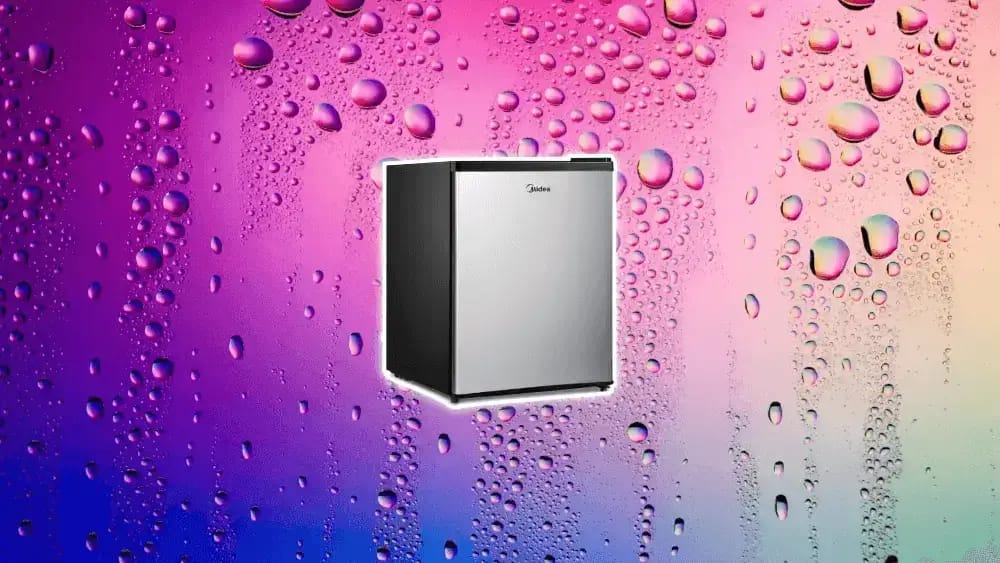Is your mini fridge getting a little too steamy for comfort? Thankfully, there are many ways to prevent mini fridge condensation and get rid of it. With a few simple steps, you can banish moisture and keep your food fresh. In this guide, we’ll share practical tips to prevent and eliminate condensation.
What is condensation?

Condensation is a natural phenomenon that occurs when water vapor in the air transforms into liquid droplets as it comes into contact with a cooler surface. This process is driven by temperature differences between the air and the surface. When warm, humid air encounters a colder object or surface, its moisture content condenses and forms tiny water droplets. This is the same principle behind droplets forming on the outside of a cold beverage glass on a warm day.
In the context of a mini fridge, condensation can occur when the interior temperature is cooler than the surrounding air. As the air inside the fridge cools down, it releases moisture in the form of condensation on various surfaces, including shelves, walls, and even food items. Excessive condensation can lead to problems such as mold and unpleasant odors.
Understanding condensation is important to manage your mini fridge’s humidity and maintain the optimal environment within your mini fridge. By using methods to stop and reduce condensation, you can make your mini fridge last longer, keep your food fresh, and make your storage space better and more efficient.
How to prevent mini fridge condensation: Step-by-step guide
Prevention is the best cure! As mentioned, condensation in your mini fridge can lead to various issues, from soggy food and mold growth to decreased efficiency and a shorter lifespan for your poor mini fridge. Fortunately, there are simple and effective ways to tackle this problem. This step-by-step guide will walk you through practical strategies to prevent condensation in your mini fridge, ensuring it remains efficient, keeps your food fresh, and lasts longer.
Step 1: Check The Seals
The rubber seals around your mini fridge’s door are important for keeping the right humidity levels. If they are damaged, extra moisture can get inside. They create an airtight barrier between the interior of the fridge and the outside environment. Their primary function is to keep the cold air in and the warm, humid air out. Make sure they’re intact and free from cracks.
How to maintain healthy mini fridge seals
To prevent excess moisture and maintain the right humidity levels in your mini fridge you have to:
- Regularly inspect the rubber seals for any signs of damage, such as cracks, tears, or stiffness.
- Clean the seals with a mild detergent and warm water to remove dirt and debris that might affect their functionality.
- Avoid overloading the door shelves, which can place strain on the seals and cause them to warp over time.
- Gently close the fridge door to avoid slamming it, which can contribute to seal wear and tear.
- If you notice any damage, promptly replace the seals to ensure proper insulation and humidity control.
Good to know: If your mini fridge’s door seals are damaged you can replace them yourself, instead of throwing your entire mini fridge away.
Step 2: Mind The Temperature
Temperature matters. If your mini fridge is too cold, you might see more condensation. Too warm, and your food won’t stay fresh. The ideal temperature is a bit cooler than your room. Finding the perfect setting can take some trial and error. But it’s worth it. The right temperature helps your food stay fresh, saves energy, and stops your fridge from getting watery. It also keeps your food safe by preventing bacteria and mold growth. So, take the time to find that perfect balance. Your food – and your fridge – will thank you.
For example:
- Summer: If you live in a hot and humid climate, the surrounding air temperature can be higher. In this case, you might need to set your mini fridge to a slightly lower temperature to compensate for the warmer external conditions and prevent excessive condensation.
- Winter: In colder climates, the external temperature is lower. You might be able to set your mini fridge to a slightly higher temperature without compromising food safety, as the colder environment helps reduce condensation.
Step 3: Store Food Properly
Moisture-holding foods, such as fruits and vegetables, can indeed be culprits in the formation of condensation within your mini fridge. When these items release moisture as part of their natural process, it can contribute to the overall humidity level inside the fridge. To counter this, it’s highly recommended to store these foods in airtight containers.

Containers will act as a barrier, preventing excess moisture from escaping into the fridge’s interior. By containing the moisture within the airtight confines of the container, you effectively reduce the humidity buildup, curbing the potential for condensation to form on surfaces and food items.
This simple yet effective practice not only helps maintain the ideal environment for your mini fridge but also extends the shelf life of your fresh produce.
Step 4: Allow Hot Food to Cool
Letting your hot leftovers cool to room temperature before putting them in your mini fridge is a simple but important step to prevent condensation problems. When you put hot food directly into the fridge, it releases steam as it cools, which adds extra moisture inside the fridge. This moisture can lead to condensation on the surfaces and food items.
By letting your food cool to room temperature first, not only you reduce the amount of steam inside your fridge but you also help extend your mini fridge’s lifespan.
Cooling your food before putting it in the fridge makes it safer to eat by preventing bacteria growth. Letting it cool down naturally keeps your leftovers safer.
Step 5: Keep the Mini Fridge Well-Ventilated
Condensation in a mini fridge often happens due to poor air circulation. To prevent this, make sure there’s enough space around the fridge for air to flow freely. When air can circulate properly, it helps maintain a consistent temperature inside. However, if the fridge is cramped and or warm, moist air can get trapped, leading to condensation. So, giving your mini fridge some breathing room is key to keeping it dry and working efficiently.
Good to know: a mini fridge with enough room to “breathe” is a healthy mini fridge that will last longer.
How to ensure good ventilation for your mini fridge
- Place your mini fridge in a well-ventilated area, away from walls, cabinets, and other obstructions.
- Leave a gap of at least a few inches between the back of the fridge and the wall.
- Ensure that the sides of the fridge have enough space for air to circulate.
Step 6: Use Food-Grade Silica Gel Packets

Using food-grade silica gel packets can be a clever and cost-effective strategy to maintain a dry environment within your mini fridge. You’ve seen these little packets before. They are often found in shoeboxes or packaged goods and they play a significant role in preserving the quality of your stored items and preventing excess humidity-related issues.
Did you know you can find food-grade silica gels? Now you know! And the best thing is that you can place a few of these packets inside your mini fridge as a defense against condensation. The silica gel acts as a moisture magnet, and helps capture and retain excess moisture, effectively lowering humidity levels within your mini fridge.
Note: please do not use regular silica gels inside your mini fridge! Always opt for the food-grade silica gel packets.
How to optimize the benefits of food-safe silica gel inside your mini fridge
- Strategically Position Packets: Place silica gel packets in areas that are more prone to humidity buildup, such as the back corners or near the vegetable crisper.
- Regularly Replace Packets: Over time, the silica gel packets become saturated with moisture. Swap them out periodically to ensure they remain effective in absorbing humidity.
- Reuse and Regenerate: You can rejuvenate silica gel packets by drying them out. Simply place the saturated packets on a baking sheet and heat them in the oven at a low temperature (around 200°F or 90°C) for a few minutes. This process restores their moisture-absorbing capabilities.
By employing food-safe silica gel packets as humidity blockers in your mini fridge, you introduce an extra layer of protection against condensation. These discreet moisture absorbers help create a consistently dry and controlled environment, minimizing the risk of moisture, mold, and deterioration of your stored items.
In conclusion, preventing mini fridge condensation requires easy yet effective actions. Maintain rubber seals and the right temperature, use airtight containers for moist foods, and ensure good ventilation. Additionally, employing food-grade silica gel packets strategically enhances your efforts. With these steps, you’ll achieve a drier, fresher, and more efficient fridge, preserving your stored items better.

With over 15 years of experience in the appliance industry, I am a passionate advocate for efficient and stylish mini fridges. I specialize in energy-saving models and compact living solutions. As a certified appliance repair technician, I have a deep understanding of mini fridge maintenance and troubleshooting.

